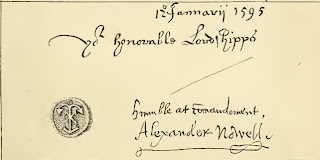n
n
n
n I’ve mentioned the Nowells ofnRead Hall several times but we owe a debt to Alexander Nowell as the man whoninvented bottled beer. Alexander was born at Read, near Whalley, in about 1507.nHe was educated at Middleton, near Manchester, and at Brasenose College,nOxford, and was later ordained as a Protestant minister.
n
n
n
 |
| Alexander Nowell |
n
n
n
nNowell was a very keen angler, and one day in 1554 he went fishing in the River Thames (although somensay it was the Ash, in Hertfordshire), and as was his habit, he decanted somenale into a bottle and stoppered it with a cork, intending to drink it later innthe day. But while Nowell sought to catch fish, Bishop Bonner sought to catchnNowell. Bishop Bonner was Bishop of London, and when Queen Mary Tudor came tonthe throne in 1553 she began to re-establish Catholicism in England with Bonnernas one of her principal tools – so enthusiastically, he earned the nicknamenBloody Bonner for his persecution of English Protestants. Bonner went lookingnfor Nowell, intending to send him to the shambles, but Nowell, aided by thenLondon merchant (and later Sheriff of London) Francis Bowyer, fled to thensafety of the continent.
n
n
n
 |
| Read Hall – Nowell’s family home |
n
n
n
nWhen Mary died in 1558 her Protestant half-sisternElizabeth became Queen and it was safe for Nowell to return to England.nResuming his hobby, he remembered the bottle of beer he had hidden away in thengrass and on finding it again, he opened “…no bottle, but a gun, such thensound at the opening thereof,” and always drank bottled beer thereafter.nThe secondary fermentation in the bottle had improved the taste of thencontents, and added fizz to the brew – cask ale, drawn from the barrel, lackednthese qualities. Alexander Nowell went on to become Dean of St Paul’snCathedral, London, under the patronage of Queen Elizabeth, (where the Dance of Death series had once been seen).
n
n
n
n
n
nOn New Year’s Day 1562, Nowell had a booknmade with pictures of the saints and martyrs new and richly bound, which wasnplaced on the Queen’s cushion in St Paul’s, as a New Year’s gift for her. ThenQueen opened the book, saw the pictures and frowned and blushed, before closingnthe book and having the verger bring her old prayer book. At the end of thenservice, rather than leaving immediately as she normally did, she went into thenvestry and confronted Nowell, asking what he meant by presenting her with suchna book. Nowell protested his ignorance, saying he only sought to please hernwith a gift, but the Queen persisted, saying she had an aversion to images andnidolatry, calling them ‘absurdities’ and asking, “… have you forgot ournproclamation against images, pictures, and Romish relics in the churches?”nAgain Nowell protested his ignorance, saying he meant no harm, so the Queennrelented, being convinced of his innocent intentions, and let the matter lie.nBut word quickly spread, and the clergymen and churchwardens of London were atnpains to remove any suspect materials, and wall paintings were whitewashednover, being replaced with more suitable Biblical texts.
n
n
n
n
n
 |
| Nowell’s signature – note the fish-hooks in the emblem. |
n
n
n
nIn 1564, Nowell foundnhimself at odds with the Queen when, during a Lenten sermon he spokendisparagingly of the crucifix, whereupon the Queen loudly rebuked him, callingnout, “To your text, Mr. Dean leave that; we have heard enough of that.” Nowellnwas so upset he was unable to carry on. In 1568, Nowell made a visit home to Lancashire,nwhere he preached many sermons, and undoubtedly returned home to Read, where henwould have been introduced to his young half-nephew Roger, then about six yearsnold. Roger would grow up to be master of Read Hall, when his father died inn1591. In 1612, he prosecuted the Pendle Witches.
n
n
n
n
n
